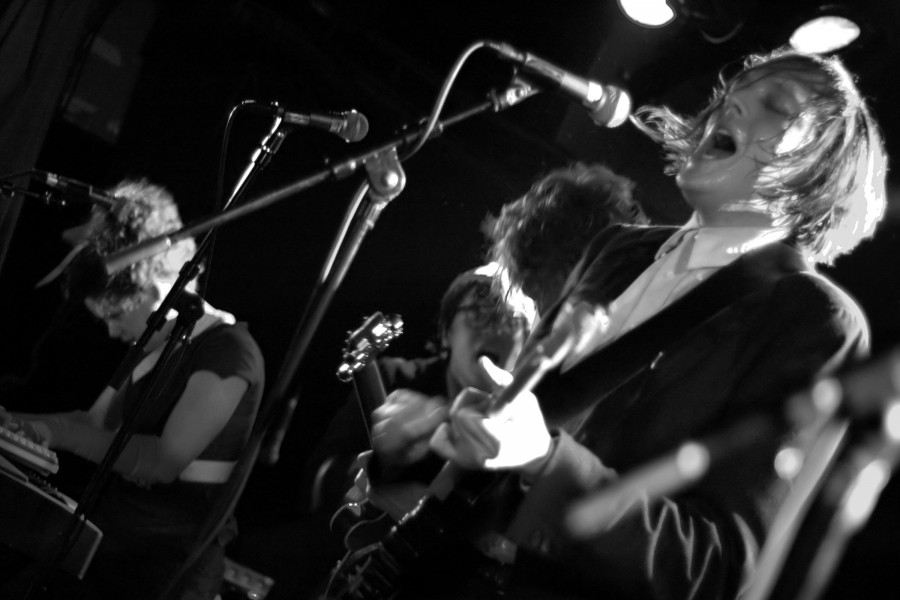Album review: Arcade Fire proves they are no Mumford & Sons:
“Reflektor is a two disc, art-rock animal that twists and turns and is utterly unpredictable.”
Arcade Fire could easily have gone the same route as Mumford & Sons.
When artists create something that is culturally relevant, or better yet, popular, the expectations of that artist change. Consumers, fans and record labels all expect more. They want more of that special something that made them want to listen, more of those hit tunes that generated ticket sales and radio airplay…more Grammys.
After breaking into mainstream pop culture with 2009’s Sigh No More, Mumford & Sons went back into the studio and produced Babel, an album with little deviation from the first. Sure, it felt more expansive (and more expensive), but all the themes from Sigh No More were still there. The harmonies and the swelling “OHs” that chewed up Billboard Hot 100 were back in full force. Consumers, fans and record labels all wanted more Mumford & Sons, and that’s exactly what they got.
Arcade Fire faced a similar situation. In 2010 their album The Suburbs became a massive, albeit unexpected, success. Having peaked at number one on the U.S. Billboard Charts, the album sold over one million copies worldwide and even snagged a Grammy for Album of the Year. Arcade Fire had brought thoughtful, catchy alternative melodies and applied them to relatable themes of suburban youth and loneliness to create a mainstream record. And they did it all without losing the indie-rock street credit they had gained from their previous two albums. Now, it was time to do it again. Or was it?
After such success, Arcade Fire could easily have succumbed to the curse of more. They could have created an album that didn’t deviate far from the tried-and-true blue print they had created with The Suburbs; a record with a few four and half minute songs with pretty hooks to be played on the radio. Sure, they would have sold records. They could have even snagged another Grammy, but would the art have been worthy of the band’s lofty standards?
Reflektor is not more of the same. Reflektor is a two disc, art-rock animal that twists and turns and is utterly unpredictable. It feels completely different than everything the band has done up to this point, yet oddly similar at the same time. Although it may turn away those fans who were expecting The Suburbs Pt. II, the album is a definitive statement that Arcade Fire is not ready to rest on its laurels.
While The Suburbs is driven mostly by well-crafted melodies, Reflektor is driven primarily by its rhythm. This may be due in part to the influence of producer James Murphy, formerly of LCD Soundsystem. The band also benefits from Haitian percussionists that have become a staple of their live act. The first disc of the record can be described, at its base level, as a dance album with rhythmic grooves that often accompany disco or, more recently, electronic artists, flowing freely. Songs change tempo at the drop of a hat, and the percussion unit as a whole brings a new life to a band not necessarily known for their drumming.
Calling this album a dance record is like calling The Clash’s Sandanista! a punk album. There are just so many influences happening that it does the art a disservice to label it specifically. “We Exist” chugs along like the best of 80s new wave, with an infectious bass line and impossibly catchy “Na Na Nas” from the lead singers. “Here Comes The Night Time” captures the spirit of the Haitian Carnival with a slow dub groove that inexplicably speeds up to a furious samba in the middle of the track before falling back down to earth for the hook.
Then, something funny happens on the first side of this record. Arcade Fire actually sound like they’re having FUN. After three albums of taking themselves just a little too seriously, the band finally shows a sense of humor. The beginning of the song, “Normal Person,” starts with a sound bite of Butler complaining about his monitors and talking to what sounds like a small rock club. The lyrics are simple, self-aware and, let’s just come out and say it, FUNNY! “I’m so confused, am I a normal person?/You know, I can’t tell if I’m a normal person?/It’s true, I think I’m cool enough, but am I cruel enough?/Am I cruel enough for you?”
The second disc of the album harkens slightly back to the old Arcade Fire, even if only at the surface. The acoustic, melody-driven songwriting pokes its head out on a few tracks, such as “Awful Sound (Oh Eurydice),” but the star-gazing synths and bright drum sounds give it a refreshing makeover, and keep in line with the sound of the rest of the album.
“Afterlife,” the second single off the album after the stellar title track, may be the closest thing resembling a pop song, with a 4/4 time signature and unremarkable chord progressions. It is also the track where Arcade Fire drops a bit of their self-aware humor from the first disc and asks big, rhetorical questions about life. “When love is gone/Where does it go?” The song might be a hit, and maybe that’s what the band was going for, but it feels a little flat compared to the excitement that is the rest of the album.
In their televised concert special Here Comes the Night Time, the band enlists a few celebrity friends to make cameos. Ben Stiller, James Franco, Zach Galifianakis, and even Bono drop in for a little face time. In one of the scenes, Michael Cera, of Superbad and Juno, plays a bartender complaining to his fellow employees (in Spanish, mind you) about the music. He says that Arcade Fire “is no Mumford & Sons.” The comment was funny on its own merit, but especially funny considering that Mumford & Sons is exactly who Arcade Fire COULD have been. They could have made a highly commercial album that sounded like The Suburbs. They could have delivered more of the same. Instead, they made Reflektor, one of the best alternative albums of the decade and one of the most important records of 2013.
James Petroskey can be contacted at: [email protected]











